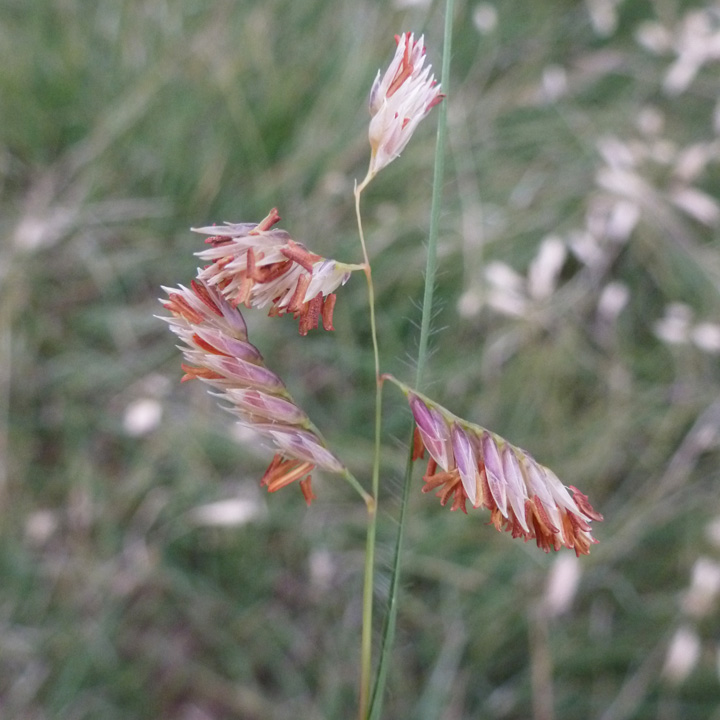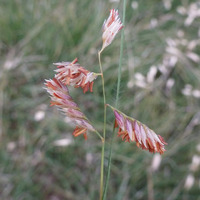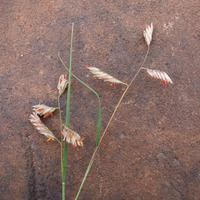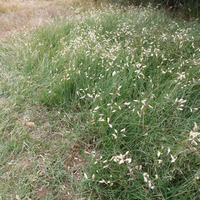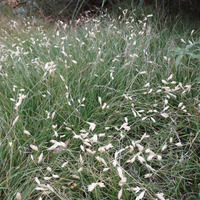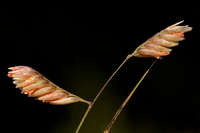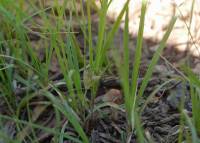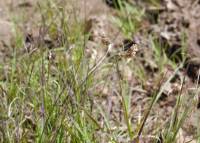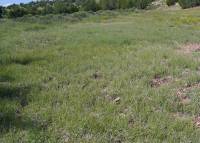Common Name: buffalograss
Duration: Perennial
Nativity: Native
Lifeform: Graminoid
General: Perennial, usually dioecious, strongly stoloniferous, sometimes mat-forming, with stems 1-30 cm, erect, mostly unbranched, with pistillate inflorescence branches much shorter than staminate inflorescences, usually with glabrous nodes.
Vegetative: Basally tufted leaves, blades 2-15 cm long, 1-2.5 mm wide, apices involute; sheaths open, rounded, often sparsely pilose near the collar, ligules membranous or of hairs, 0.5-1 mm.
Inflorescence: Staminate inflorescence terminal, usually exceeding upper leaves, panicles of 1-3 racemosely arranged, unilateral, pectinate branches, not enclosed at maturity; staminate spikelets 4-6 mm, with 2 florets, glumes unequal, glabrous, 1 or 2 veined, lemmas, 3-veined, glabrous, unawned; pistillate inflorescences terminal, panicles partially within bracteate leaf sheaths, branches 2-3, 2.5-4.5 mm, burlike with 3-5 spikelets; disarticulation at base of panicle branches; pistillate spikelets with 1 floret, almost enclosed by upper glumes; lower glume irregular and reduced, upper globose, white, indurate with 3 awnlike teeth; lemmas membranous, glabrous, unawned or shortly 3-awned.
Ecology: Found on limestone soils around 5,000 ft (1524 m); flowers fall.
Notes: Widespread in the plains, but rare in Arizona. Found in Coconino and Yavapai counties. In its southern range it can be confused with Hilaria belangeri, which has pilose nodes, and Cathestecum erectum (now: Bouteloua erecta) which has three spikelets per node and distinctly awned lemmas.
Ethnobotany: Unknown, but other species in the genus have many uses.
Etymology: Bouteloua named for brothers Claudio (1774-1842) and Esteban (1776-1813) Boutelou Agraz, Spanish botanists and horticulturalists; while dactyloides comes from Latin dactylis and Greek daktylos for finger, referring to the grass as finger-like.
Synonyms: Buchloe dactyloides, Bulbilis dactyloides, Sesleria dactyloides, several others, see Tropicos
Editor: SBuckley, 2010
Perennial herb, spreading by runners, sometimes mat-forming 1 - 32 cm tall
Leaves: with an open sheath that is often sparsely soft-haired near the collar, and a 0.5 - 1 mm long ligule that is either membranous or composed of hairs. The blade is 2 - 15 cm long, 1 - 2.5 mm wide, usuallly flat near the base but with the margins rolling toward the upper surface of the midvein (involute) at the tip, curling when dry, and hairless or sparsely soft-haired.
Flowers: either male or female, borne on separate plants (dioecious).
Fruit: a caryopsis, 2 - 2.5 mm long.
Culm: 1 - 30 cm long, erect, usually unbranched, with mostly hairless nodes. Culms bearing female inflorescences are much shorter than those bearing male inflorescences.
Male inflorescence: terminal, branched (panicle), usually rising above the upper leaves, with spikelets arranged in two rows on the one to four branches.
Female inflorescence: terminal, branched (panicle), partially surrounded by the leaf sheath, with two to four branches (2.5 - 4.5 mm long) and three to seven spikelets per branch.
Male spikelets: 4 - 6 mm long, 1.3 - 1.8 mm wide, consisting of two florets.
Female spikelets: 7 mm long, about 2.5 mm wide, consisting of one floret.
Male florets: with unequal glumes that are hairless and one- or two-veined, hairless lemmas that are three-veined and unawned, and brownish to red or orange anthers 2.5 - 3 mm long.
Female florets: with the upper glume nearly surrounding the floret and the lower glume irregular and reduced. The branch axes and base of the upper glumes are white, spherical, hardened, and have three awnlike teeth. Lemmas are membranous, three-veined, and hairless.
Similar species: No information at this time.
Flowering: early June to late August
Habitat and ecology: Introduced from the western United States, this species grows in railroad ballast and mowed turf.
Occurence in the Chicago region: non-native
Etymology: Buchloe comes from the Greek words bous, meaning "cow or ox," and chloe, meaning grass. Dactyloides means "like Dactylis," another grass species.
Author: The Morton Arboretum
Staminate culms 1-2 dm, the pistillate 2-5 cm; lf-blades sparsely pilose, 3-10 cm, ca 2 mm wide; staminate spikes 6-15 mm; pistillate spikelets (second glume) 6 mm; 2n=40. Dry prairies and plains; w. Minn. and w. Io., n. to Alta., w. to the mts., s. to Ariz. and N.M.; the most important constituent of the short-grass prairies. (Bulbilis d.)
Gleason, Henry A. & Cronquist, Arthur J. 1991. Manual of vascular plants of northeastern United States and adjacent Canada. lxxv + 910 pp.
©The New York Botanical Garden. All rights reserved. Used by permission.


